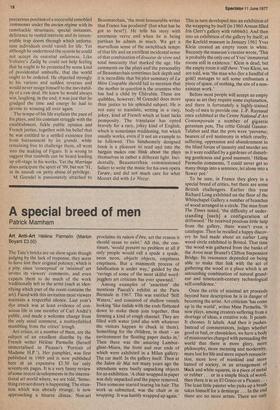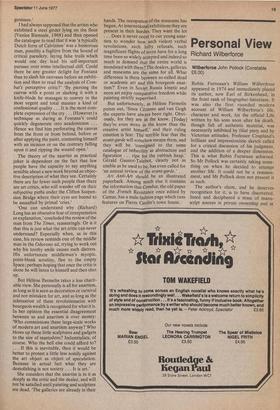A special breed of men
Patrick Marnham
Art Anti-Art Helene Parmelin (Marion Boyars 0.50) The Tate's bricks are on show again though judging by the lack of response, they seem to have lost their original potency; which is a pity, since 'conceptual' or 'minimal' art invites its viewers' comments, and even expects them to do much of the work traditionally left to the artist (such as identifying which part of the room contains the art). Faced with this invitation most viewers maintain a respectful silence. Last year's dye attack was at least evidence of conscious life in one member of Carl Andre's public, and made a welcome change from the only usual comment, a multisyllabled mumbling from the critics' trough.
Art critics, or a number of them, are the subject of an excellent diatribe by the French writer Helene Parmelin (herself immortalised in Picasso's 'Portrait of Madame H.P.'). Her pamphlet, was first published in 1969 and is now published here at an expensive £3.50 for only seventy-six pages. It is a very funny review of some recent developments in the international art world where, we are told, 'Something extraordinary is happening. The situation which was already strange, is now approaching a bizarre climax. Non-art
proclaims its raison d'être, art the reason it should cease to exist.' All this, she continues, 'would present no problem at all if only people would call a spade a spade, neon neon, objects objects, emptiness emptiness. But a mammoth process of falsification is under way,' guided by the 'ravings of some of the most skilful wordjugglers art criticism has ever spawned.'
Among examples of 'anaetism' she mentions Pascali's exhibit at the Paris Biennale in 1967. This was entitled 'Still Waters,' and consisted of shallow vessels looking 'like tinlids with the ends flattened down to make them join together, thus forming a kind of rough channel. They are filled with water (and also with whatever the visitors happen to chuck in them). Something for the children, in short — an environment for floating paper ducks, in.' Then there was the amazing Lamborghini—Miura, the front and rear ends of which were exhibited in a Milan gallery: The car itself. In the gallery itself. Then at the Salon de Mai not many years ago the attendants were busily unpacking objects for an exhibition. 'A chair wrapped in paper was duly unpacked and the paper removed. Then someone started tearing his hair. The work as submitted, was the chair in its wrapping. It was hastily wrapped up again.' This in turn developed into an exhibition of the wrapping by itself (in 1960 Arman filled Iris Cleft's gallery with rubbish). And then into an exhibition of the gallery by itself; at the Krefeld museum in January 1961 Yves Klein created an empty room in white. Recently the museum's curator wrote, 'This is probably the only one of Yves' immaterial rooms still in existence.' Klein is dead, but the empty room is still there. Yves Klein, we are told, was `the man who (for a handful of gold) manages to sell some enthusiasts a piece of space, of nothing, the site of a nonexistent work.'
Before most people will accept an empty space as art they require some explanation, and there is fortunately a highly-trained body of men to provide one. J.-P. Raynaud once exhibited at the Centre National d'Art Contemporain a number of gigantic geranium pots. The critic Gerald GassiotTalabot said that the pots were 'perverse; bearers of evil testimony in which cruelty, suffering, oppression and abandonment to the blind forces of insanity and murder are as it were codified by a gardener of disturbing gentleness and good manners.' Helene Parmelin comments, 'I could never get so many things into a sentence, let alone into a flower pot.'
To be sure, in France they glory in a special breed of critics, but there are some British challengers. Earlier this year Richard Long exhibited on the floor of the Whitechapel Gallery a number of branches of wood arranged in a circle. The man from The Times noted, 'the difficulty of understanding [such] a configuration of driftwood.' He received precious little help from the gallery, there wasn't even a catalogue. Then he recalled a happy discovery he had made about an earlier Long wood circle exhibited in Bristol. That time 'the wood was gathered from the banks of the Avon near Bruners Clifton Suspension Bridge. Its resonance depended on being able to make that link with the act of gathering the wood at a place which is an astounding combination of natural grandeur and nineteenth-century technological self-confidence.'
Once the critic of minimal art proceeds beyond bare description he is in danger of becoming the artist. Art criticism 'has come up in the world', writes Mme Parmelin. now plays, among creators suffering from a shortage of ideas, a creative role. It points. It chooses. It labels. And then it pushes. Instead of commentators, judges whether good or bad, or chroniclers, we have a body of missionaries charged with persuading the world that there is more glory, more philosophy, more meaning and modernity, more lust for life and more superb renunciation, more love of mankind and more hatred of society, in an arrangement of lack and white squares, in a piece of metal or rubber.. . or in a simple block of wood, then there is in an El Greco or a Picasso. • • The least little painter who picks up a brush takes himself for a demiurge . . . In the end there are no more artists. There are only I had always supposed that the artists who exhibited a steel girder lying on the floor (Venice Biennale, 1968) and then opened the catalogue to read that it was 'a typically Dutch form of Calvinism' was a humorous man, possibly a fugitive from the hound of critical pseudery, laying false trails which would one day lead his self-important pursuer over some intellectual cliff. Could there be any greater delight for Fontana than to slash his canvases before an exhibition and then to read the analysis of Combat's perceptive critic?' By piercing the canvas with a point or slashing it with a knife-blade he manages to convey in the most urgent and total manner a kind of confessional quality .. . It is the most complete expression of the cry . . . (However) a technique as daring as Fontana's could quickly degenerate into academicism . . . Hence we find him perforating the canvas from the front or from behind, before or after applying the paint, contenting himself with an incision or on the contrary falling upon it and ripping the wound open.'
The theory of the ariartist as practical joker is dependent on the fact that few people have the capacity to say anything sensible about a new work beyond an objective description of what they see. Certainly there are far fewer such people than there are art critics, who will wander off on their subjective paths under the Clifton Suspension Bridge where their eyes are bound to be assaulted by primal 'cries.'
'One can understand why (Richard) Long has an obsessive fear of interpretation or explanation,' concluded the review of the man from The Times, reassuringly. Or is it that this is just what the art critic can never understand? Especially when, as in this case, his review reminds one of the middle man in the Odorono ad, trying to work out why his toothy smile causes such distress. His unfortunate middleman's myopic, point-blank scrutiny, flee to the empty Space; perhaps hoping that once the critic is alone he will listen to himself and then shut up.
But Helene Parmelin takes a less charitable view. She personally is all for anartism, as long as it is seen as decoration or carnival and not mistaken for art, and as long as the infatuation of these revolutionaries with bourgeois wealth is recognised for what it is. In her opinion the essential disagreement between us and anartism is over money: 'Who commissions these large-Scale works of modern art and anartism anyway? Who blows up these little sculptures and gadgets to the size of mastodons? Industrialists, of course. Who the hell else could afford to? . . . If this is inevitable, then it would be better to protest a little less noisily against the art object as object of speculation. Because in actual fact what they are dernolishing is not society . . . It is art.'
She considers that the anartist is in it as deeply as the critic and the dealer, and will not be satisfied until painting and sculpture are dead. The galleries are already in their hands. The occupation of the museums has begun. At international exhibitions they are present in their hordes. They want the lot . . . Does it never occur to our young anartists to wonder how such violent verbal revolutions, such lofty refusals, such magnificent flights of scorn have for a long time been so widely accepted and indeed so much in demand that the entire world Is inundated with them? The dealers, galleries and museums are the same for all. What difference is there between so-called dead or academic art and this bourgeois anartism?' Even in Soviet Russia kinetic and neon art enjoy comparative freedom while painting strictly supervised.
But unfortunately, as Helene Parmelin points out, 'Since Cezanne and van Gogh the experts have always been right. Obviously, for they are in the know. [Today] they're even more in the know than the creative artist himself,' and their ruling emotion is fear. The terrible fear that the avant-garde will somehow escape them, and they will be 'consigned to the same catalogue of imbecility as abstraction and figuration . . . ripe for the rubbish heap.' Gerald Gassiot-Talabot, clearly not as nimble as he used to be, has even called for 'an annual review of the avant-garde.'
Art Anti-Art should be an illustrated paperback. Among much else it contains the information that Combat, the old paper of the ,French Resistance once edited by Camus, has a male fashion page which runs features on Pierre Cardin's town house.



































 Previous page
Previous page